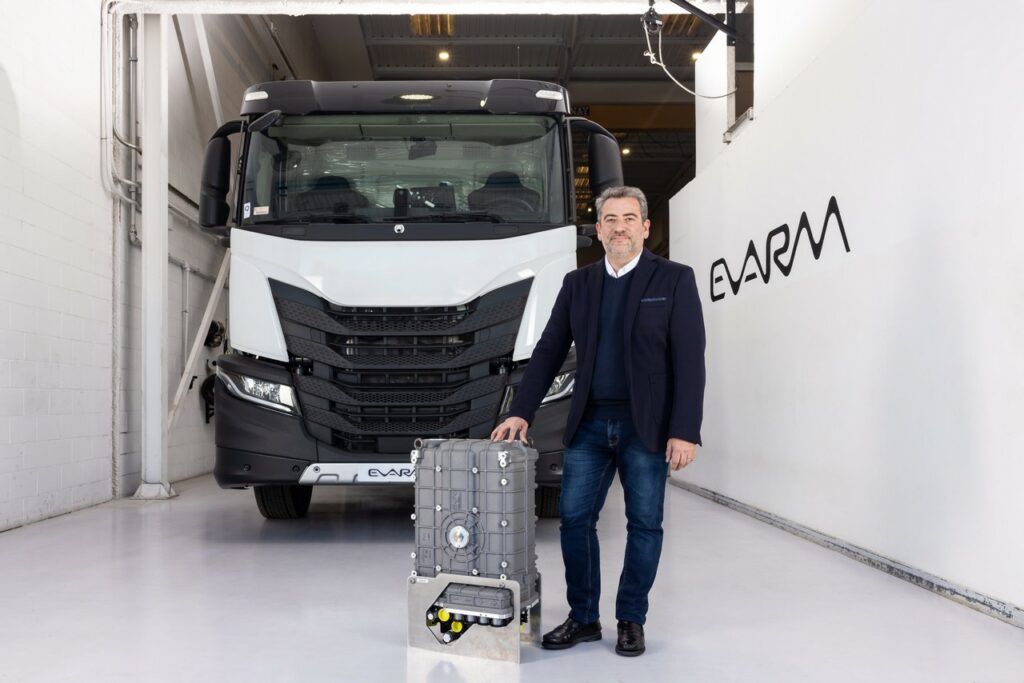In a logistics landscape dominated by weight penalties and range anxiety, Spain’s EVARM is taking a different route. With the debut of its hydrogen fuel cell system in an Iveco S-Way truck, EVARM is entering the high-stakes race to decarbonize heavy-duty urban transport—not by retrofitting batteries, but by betting on compact, high-efficiency fuel cell propulsion.
Why Batteries Fall Short for Urban Trucks
Electric propulsion has made significant inroads in light-duty vehicles, but its application in heavy urban fleets has remained constrained by practical limits. For a 26-tonne vehicle like the Iveco S-Way, battery-based systems demand a trade-off: significant loss of cargo capacity, restricted range, and longer charging times. According to current industry benchmarks, a comparable battery-electric truck would require upwards of 600–800 kWh to deliver a usable urban range, adding several tonnes in battery weight and reducing operational flexibility.
By contrast, EVARM’s hydrogen solution claims a weight-saving footprint of 80% compared to battery systems, while offering a 450-kilometer range—sufficient for typical municipal service cycles. That performance comes without compromising payload capacity, a critical consideration for commercial fleet operators.
Technical Edge: Efficiency, Integration, and Collaboration
At the heart of this transition is the 120 kW EVARM 03 fuel cell engine. Co-developed with German engineering partner EKPO and supported by the European Institute of Innovation and Technology for Urban Mobility (EITUM), the unit achieves 60% electrical efficiency—substantially higher than the 30–40% typical of diesel engines.
This efficiency is not theoretical. It translates into a viable real-world performance envelope, particularly when integrated into a drivetrain that includes a 250 kW electric motor. Importantly, this is not a concept model. The powertrain has been installed in an operational platform, replacing the diesel engine, fuel tanks, and emissions systems of the Iveco S-Way. The retrofit allows for cleaner operation without the downtime or infrastructure overhauls associated with full vehicle replacements.
Industrial Partnerships and Policy Backing
The development has also been bolstered by Spanish automotive engineering firm IDIADA Applus+ under the Veh2Dem project, with funding and technical backing from Spain’s Institute for Energy Diversification and Saving (IDAE). These partnerships reflect a growing European trend toward public-private alignment in decarbonizing transport.
Beyond engineering, EVARM’s hydrogen truck has secured its first client: PreZero, the environmental services arm of retail giant Schwarz Group. The vehicle will be piloted for municipal waste collection in urban centers—an application where stop-start driving, predictable routes, and access to hydrogen refueling infrastructure make a strong case for fuel cell deployment.
Is the TCO Argument Stacking Up?
While no total cost of ownership (TCO) data has yet been released, hydrogen vehicle economics remains a critical unknown. Even with improved efficiency and weight savings, hydrogen fuel cell trucks still contend with high upfront costs, infrastructure scarcity, and fluctuating hydrogen prices. However, early adopters like PreZero may be banking on medium-term cost parity, especially if fuel cell systems prove more durable and require less maintenance than battery-heavy platforms.
Moreover, regulatory pressure is tightening. With urban emission zones expanding across the EU, fleet operators are seeking alternatives that meet both operational needs and environmental mandates. In this context, EVARM’s offering could serve as a niche but growing solution—provided it proves scalable.
Urban Logistics at a Crossroads
The move by EVARM highlights a shift from hydrogen being a theoretical alternative to becoming a tested application within city logistics. It’s a challenge to the dominant narrative that batteries are the de facto path for vehicle electrification.
Instead of positioning hydrogen as a universal fix, EVARM’s initiative underscores its situational advantages: high power-to-weight efficiency, fast refueling, and superior range in weight-sensitive applications. If the pilot program with PreZero delivers tangible emission reductions and operational stability, fuel cells may begin to move beyond prototypes into broader municipal and industrial use cases.
For now, the sector is watching. The data generated from this deployment will play a defining role in whether EVARM’s hydrogen bet is the start of a broader trend or a niche experiment in an evolving decarbonization landscape.
